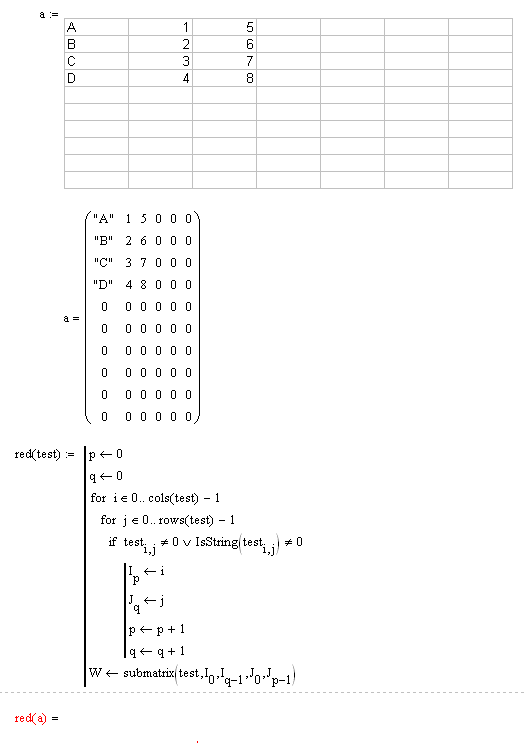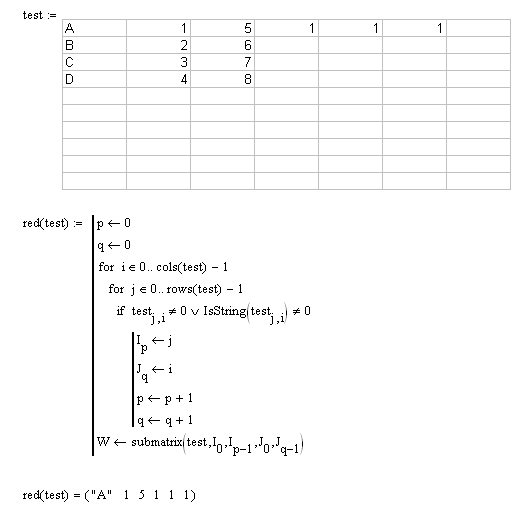Community Tip - You can change your system assigned username to something more personal in your community settings. X
- Subscribe to RSS Feed
- Mark Topic as New
- Mark Topic as Read
- Float this Topic for Current User
- Bookmark
- Subscribe
- Mute
- Printer Friendly Page
How to extract non zero submatrix to a matrix table
- Mark as New
- Bookmark
- Subscribe
- Mute
- Subscribe to RSS Feed
- Permalink
- Notify Moderator
- Labels:
-
Other
Accepted Solutions
- Mark as New
- Bookmark
- Subscribe
- Mute
- Subscribe to RSS Feed
- Permalink
- Notify Moderator
Neptali Barte wrote:
Yes, it works! Thanks Raiko. My another problem is that when I add more values in the columns of the 1st row only (See snapshot). It only gets the first row only. I want to include in the results the values of the second to the last row where there is a value even when there are zeroes below the 1st row.
Change your last line to
submatrix(test,min(I),max(I),min(J),max(J))
Stuart
- Mark as New
- Bookmark
- Subscribe
- Mute
- Subscribe to RSS Feed
- Permalink
- Notify Moderator
Use submatirx()

- Mark as New
- Bookmark
- Subscribe
- Mute
- Subscribe to RSS Feed
- Permalink
- Notify Moderator
Yup, the answer is quite correct but my goal is that, I don't want to update or change the value inside the submatrix function everytime I add values to either the rows or colums of "test" table. "test" is actually an excel component that I made with an output range say A1:F100. Anytime, I want to add values in the rows and columns in ascending order, the remaining cells in the range will be zero. An I only wanted to get the values in the cells that have an input in excel component. Do somebody have a function to do this?
- Mark as New
- Bookmark
- Subscribe
- Mute
- Subscribe to RSS Feed
- Permalink
- Notify Moderator
Hello Neptali,
this function does the trick. However, if the pattern of the non-zero values is irregular (e.g. interspersed with zeros) it will generate an array that still contains some zeros.
Raiko
- Mark as New
- Bookmark
- Subscribe
- Mute
- Subscribe to RSS Feed
- Permalink
- Notify Moderator
I'm using an excel component for the table and I got the below error in red. Why?

- Mark as New
- Bookmark
- Subscribe
- Mute
- Subscribe to RSS Feed
- Permalink
- Notify Moderator
Neptali Barte wrote:
I'm using an excel component for the table and I got the below error in red. Why?
Because you have i counting columns instead of rows (and j counting rows instead of columns). the index test[i,j identifies row i, column j. Change them round and swap q and p in your submatrix call.
Stuart
PS,
a. There is no need to add the <>0 test after the IsString call; Mathcad treats all non-zero values as true and as IsString evaluates to 1 for a string, then it will be (by definition) not equal to zero. I don't think you need the test anyway, all you're after is non-zero elements and a string is <> 0.
b. There is no need to assign the result of submatrix to W; it's redundant as you don't use W and Mathcad will simply return the value of the submatrix if you remove the W<- bit.
- Mark as New
- Bookmark
- Subscribe
- Mute
- Subscribe to RSS Feed
- Permalink
- Notify Moderator
Hello Stuart,
thanks for the remarks. You're right, some of the code is redundant.
Raiko
P.S.
Neptali, does the function work now?
- Mark as New
- Bookmark
- Subscribe
- Mute
- Subscribe to RSS Feed
- Permalink
- Notify Moderator
Yes, it works! Thanks Raiko. My another problem is that when I add more values in the columns of the 1st row only (See snapshot). It only gets the first row only. I want to include in the results the values of the second to the last row where there is a value even when there are zeroes below the 1st row.

- Mark as New
- Bookmark
- Subscribe
- Mute
- Subscribe to RSS Feed
- Permalink
- Notify Moderator
Neptali Barte wrote:
Yes, it works! Thanks Raiko. My another problem is that when I add more values in the columns of the 1st row only (See snapshot). It only gets the first row only. I want to include in the results the values of the second to the last row where there is a value even when there are zeroes below the 1st row.
Change your last line to
submatrix(test,min(I),max(I),min(J),max(J))
Stuart






